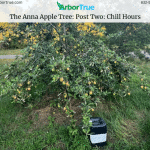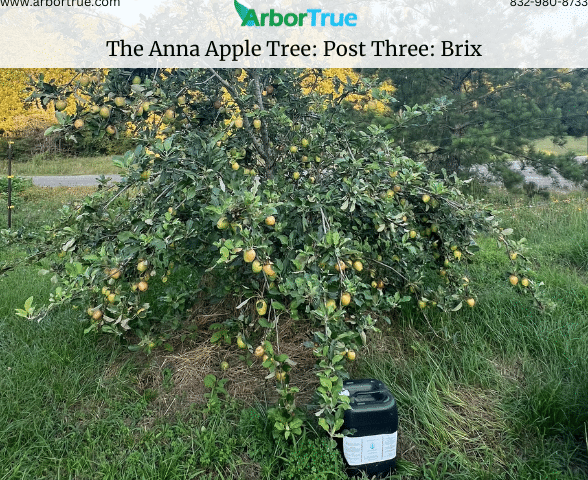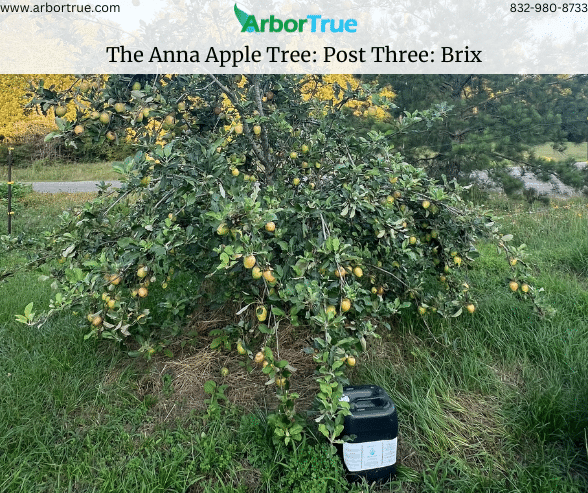
The Anna Apple Tree: Post Two: Chill Hours
June 26, 2024
Mushroom Monday: Leucocoprinus cretaceus
July 1, 2024
The Anna Apple Tree: Post Three: Brix
This is our third in a series of posts about the Anna apple tree. In the first post, we covered the basics. In the second, we looked at chill hours. In today’s post, we use the Anna apple tree as a way to look at the concept of Brix.
Brix
The Basic Concept
One concept related to fruit trees is Brix. Brix, which is talked about in terms of degrees, is a measure related to how much sugar is in a solution. It is the weight of the sugar in a solution divided by the weight of the entire solution. The degrees refer to the percentage, so that if something had 10 degrees Brix, 10% of the weight of the solution would be sugar. The higher the Brix, the more sugar there is.
Brix and Plant Health
Brix and General Plant Health
Brix is related to many things in plants, and can be a general indicator of their general health. A higher Brix can often relate to a plant that has a higher nutrient density and one that could be healthier as well as having a greater resilience than comparable plants with lower Brix. The idea is that if a plant has a high Brix, then it can indicate that photosynthesis in the plant, as well as the plant’s ability to take up nutrients, are working properly.
Brix and Pest Resistance
Although a number of factors influence a plant’s resistance to diseases and pests, generally speaking if a plant has a higher Brix level, it can be more resistant to diseases and pests, all else being equal. There are a number of reasons for this that generally come from the idea that a plant with a higher Brix level can be healthier than a comparable plant, and healthier plants are more resistant to disease and pests.
One reason for the increase in resistance is that pests generally target plants that are already weakened. A higher Brix can indicate a healthier plant, and a healthier plant may be less attractive to pests. Plants with higher Brix levels can have a higher nutrient density. Plants with higher nutrient densities can sometimes be harder for insects to process and digest and therefore they may be less likely to target them.
Another reason is that plants that are healthier can have more robust walls around their cells. These walls can be more difficult for pests to get through. As Brix is a general measure of plant health, a higher Brix can be an indication that a plant might have more robust walls.
An additional reason is that when a plant is healthier it can have more enzymes and microorganisms. These enzymes and microorganisms can repel pests.
A fourth reason is that plants with higher Brix have a higher concentration of sugar. When insects consume plants with a higher concentration of sugar, it can cause them to dehydrate. This can cause the insects harm and deter them.
You may have noticed in the photographs that there were no webworms present on the Anna apple tree, even though webworms were prevalent in the area at the time of the photograph. One reason for this is the relatively higher Brix level of the tree. One possibility is that the plant could have had better health, stronger cell walls, additional enzymes and microorganisms, and a higher concentration of sugar, and these could have combined to help defend the tree against webworms.
How is Brix Measured?
We noted above that Brix were measured by degrees and this was a measure of the amount of dissolved solids (in this case sugar) in a liquid solution. In terms of notation, it might be noted as 15 Brix if a sample taken had 15% sugar. Brix can be noted just as Brix, Degrees Brix, or °Bx.
Brix can be measured by a device called a refractometer. It is based on how light travels through a liquid and how this changes depending on the amount of dissolved solids in the liquid. By looking at how much the light changes (the angle that it travels will change) the degrees Brix can be measured. The readings taken with a refractometer can vary based on temperature and this must be taken into account when taking measurements. The readings are based on the mass of the sugar, the mass of the solution, and the volume of the solution.
Brix can be seen as an estimate of the amount of sugar because there will generally be other things dissolved in a liquid from a plant (e.g., in fruit juice) besides sugar, and these are also measured by the reading (which measures solids, not just sugar). It can give a general indication though.
The Brix measure from a sample taken from a plant can vary with plant genetics, sunlight, temperature, growing conditions, and the time of fruit harvest.
What are the Degrees Brix of Apples?
As noted, the specific degrees Brix can vary based upon a number of factors. Generally, apples have a range of 11 to 18 degrees Brix. A typical reading might be between 12 and 13.
To put this in a little perspective, oranges have a range of 4 – 13 degrees Brix, grapes have a range of 14 – 19, and jam can have a range of 60 to 70.
If you liked learning about Anna apple trees and Brix, check out our other posts on our TrueTreeTalk blog. Follow us on Facebook to keep up with these and other posts. Also, check back here for another post about Anna apple trees.
* * *
ArborTrue is a science-based tree-service company in the greater Houston area. We provide a range of services including tree trimming, tree pruning, tree removal, tree planting, arborist consultations, and more. Call us today at 832-980-8733 or reach out to us online to schedule an appointment.




